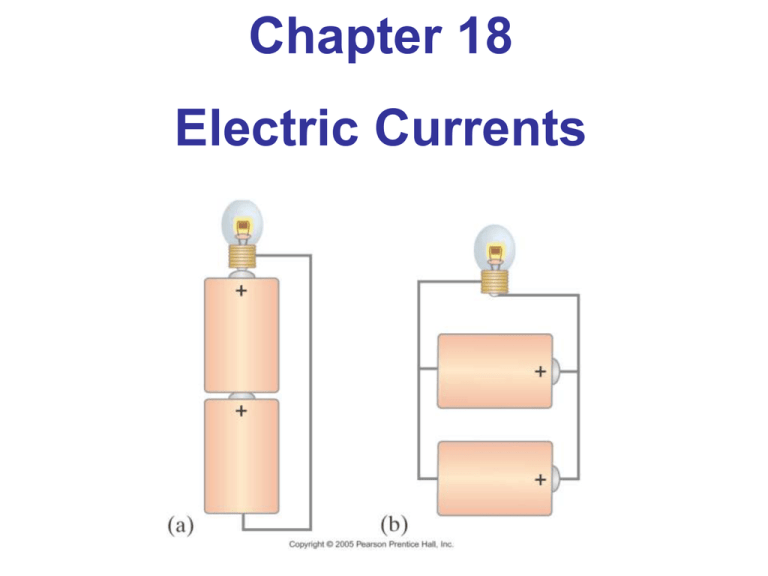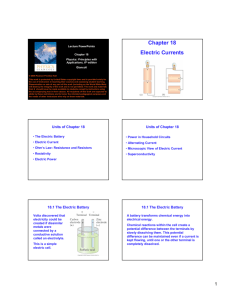File
advertisement

Chapter 18 Electric Currents 18.1 The Electric Battery Volta discovered that electricity could be created if dissimilar metals were connected by a conductive solution called an electrolyte. This is a simple electric cell. 18.1 The Electric Battery A battery transforms chemical energy into electrical energy. Chemical reactions within the cell create a potential difference between the terminals by slowly dissolving them. This potential difference can be maintained even if a current is kept flowing, until one or the other terminal is completely dissolved. 18.1 The Electric Battery Several cells connected together make a battery, although now we refer to a single cell as a battery as well. 18.2 Electric Current Electric current is the rate of flow of charge through a conductor: (18-1) Unit of electric current: the ampere, A. 1 A = 1 C/s. 18.2 Electric Current A complete circuit is one where current can flow all the way around. Note that the schematic drawing doesn’t look much like the physical circuit! 18.2 Electric Current In order for current to flow, there must be a path from one battery terminal, through the circuit, and back to the other battery terminal. Only one of these circuits will work: 18.2 Electric Current By convention, current is defined as flowing from + to -. Electrons actually flow in the opposite direction, but not all currents consist of electrons. 18.3 Ohm’s Law: Resistance and Resistors The ratio of voltage to current is called the resistance: (18-2a) (18-2b) 18.3 Ohm’s Law: Resistance and Resistors In many conductors, the resistance is independent of the voltage; this relationship is called Ohm’s law. Materials that do not follow Ohm’s law are called nonohmic. Unit of resistance: the ohm, Ω. 1 Ω = 1 V/A. 18.3 Ohm’s Law: Resistance and Resistors Time for a Gizmo! 18.3 Ohm’s Law: Resistance and Resistors Standard resistors are manufactured for use in electric circuits; they are color-coded to indicate their value and precision. Mnemonic Devices My Very Energetic Mother Just Served us Noodles The names of the planets in the solar system, in order from the Sun out: Mercury, Venus, Earth, Mars, Jupiter, Saturn, Uranus, Neptune- Poor Pluto! Mnemonic Devices ROY G BIV The colors of the rainbow in the order of their appearance: red, orange, yellow, green, blue, indigo, and violet Mnemonic Devices Divorced, beheaded, died. Divorced, beheaded, survived For remembering the fates of King Henry VIII’s six wives. Mnemonic Devices Every Good Boy Deserves Fudge and FACE In music theory, these represent the notes of the treble (G) clef: the lines (EGBDF) and the spaces (FACE). Mnemonic Devices HOMES The names of the Great Lakes: Huron, Ontario, Michigan, Erie, Superior Mnemonic Devices ABC CPR Procedure: Airway, Breathing, Circulation Mnemonic Devices Kings Play Chess On Funny Green Squares The Linnean classification system: Kingdom, Phylum, Class, Order, Genus, Species 18.3 Ohm’s Law: Resistance and Resistors 18.3 Resistor Code Mnemonic B B R O Y G B V G W G S N 18.3 Ohm’s Law: Resistance and Resistors Some clarifications: • Batteries maintain a (nearly) constant potential difference; the current varies. • Resistance is a property of a material or device. • Current is not a vector but it does have a direction. • Current and charge do not get used up. Whatever charge goes in one end of a circuit comes out the other end. 18.4 Resistivity The resistance of a wire is directly proportional to its length and inversely proportional to its cross-sectional area: (18-3) The constant ρ, the resistivity, is characteristic of the material. 18.4 Resistivity Time for a Gizmo! 18.4 Resistivity 18.4 Resistivity For any given material, the resistivity increases with temperature: (18-4) Semiconductors are complex materials, and may have resistivities that decrease with temperature. 18.5 Electric Power Power, as in kinematics, is the energy transformed by a device per unit time: (18-5) 18.5 Electric Power The unit of power is the watt, W. For ohmic devices, we can make the substitutions: (18-6a) (18-6b) 18.5 Electric Power What you pay for on your electric bill is not power, but energy – the power consumption multiplied by the time. We have been measuring energy in joules, but the electric company measures it in kilowatthours, kWh. 18.6 Power in Household Circuits The wires used in homes to carry electricity have very low resistance. However, if the current is high enough, the power will increase and the wires can become hot enough to start a fire. To avoid this, we use fuses or circuit breakers, which disconnect when the current goes above a predetermined value. 18.6 Power in Household Circuits Fuses are one-use items – if they blow, the fuse is destroyed and must be replaced. 18.6 Power in Household Circuits Circuit breakers, which are now much more common in homes than they once were, are switches that will open if the current is too high; they can then be reset. 18.7 Alternating Current Current from a battery flows steadily in one direction (direct current, DC). Current from a power plant varies sinusoidally (alternating current, AC). 18.7 Alternating Current Time for a Gizmo! 18.7 Alternating Current The voltage varies sinusoidally with time: as does the current: (18-7) 18.7 Alternating Current Multiplying the current and the voltage gives the power: 18.7 Alternating Current Usually we are interested in the average power: 18.7 Alternating Current The current and voltage both have average values of zero, so we square them, take the average, then take the square root, yielding the root mean square (rms) value. (18-8a) (18-8b) Conductivity Movie






